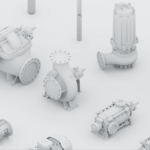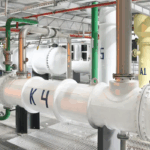A vacuum pump works by creating a pressure difference between the volume to be processed and the environment. Main stages of operation:
- Gas capture:
The gas from the volume enters the working chamber of the pump. - Compression:
In the working chamber, the gas is compressed by mechanical or physical action. - Deletion:
The compressed gas is discharged from the working chamber into the atmosphere or a special collection vessel.
Types of vacuum pumps differ in the way they create a vacuum:
- Mechanical pumps:
Vacuum is created by moving parts such as pistons, plates or a rotor. - Diffusion pumps:
A stream of oil or mercury vapour is used to create a deep vacuum. - Turbomolecular pumps:
They create a vacuum due to the high-speed rotation of the blades. - Cryopumps:
Low temperatures are used to condense gases and vapours.
Areas of application
- Pharmaceuticals:
- They are used in the processes of drying, degassing, and the production of sterile preparations.
- Chemical industry:
- Creating vacuum in reaction systems, purifying gases, evaporating solvents.
- Metallurgy:
- They are used for vacuum casting, heat treatment and brazing of metals.
- Food industry:
- Vacuum packaging of food, removing air from food products such as sauces or juices.
- Scientific research:
- Physical and chemical experimentation facilities, vacuum chambers for evaporation or coating.
- Electronics:
- Production of semiconductors, vacuum sputtering of films.
Features of vacuum pumps
- Types of vacuum:
- Rough vacuum: Corresponds to low vacuum levels (1-1000 mbar).
- Medium vacuum: The pressure is within 10-³-1 mbar.
- Deep vacuum: Pressure below 10-³ mbar, used for specialised applications.
- Resistance to aggressive environments:
Special models can handle aggressive gases or vapours. - Pumping speed:
Determines how much gas the pump can remove per unit of time. - Energy efficiency:
Modern models are equipped with economical engines, which reduces energy consumption. - Compactness:
Some pumps have a modular design that allows them to be integrated into compact systems. - Noise and vibration:
The low-noise models are suitable for laboratory or medical applications.
How do I choose the right vacuum pump?
- Vacuum level:
Determine which vacuum level is required for your process (rough, medium or deep vacuum). - Productivity:
Consider the volume of the system to be pumped and the pumping speed. - Type of environment:
Make sure that the pump is suitable for your type of gas or vapour (corrosive, toxic, abrasive). - Materials:
For use with aggressive substances, choose models made of stainless steel, Teflon or other chemically resistant materials. - Operating conditions:
Consider the temperature, humidity and frequency of use of the pump. - Protection system:
Choose a pump with protection against overheating, dry running and mechanical wear.



